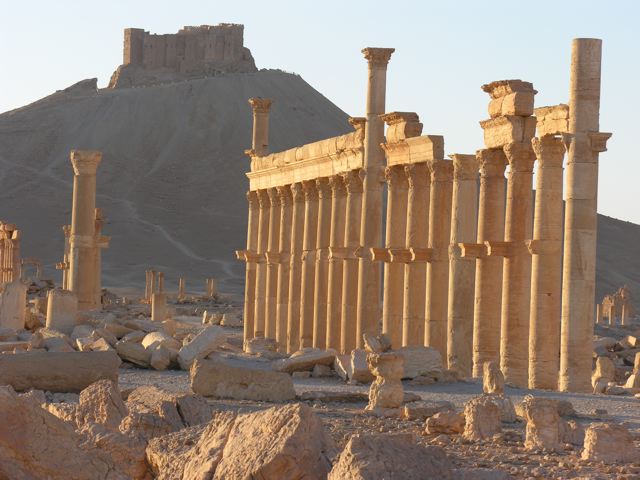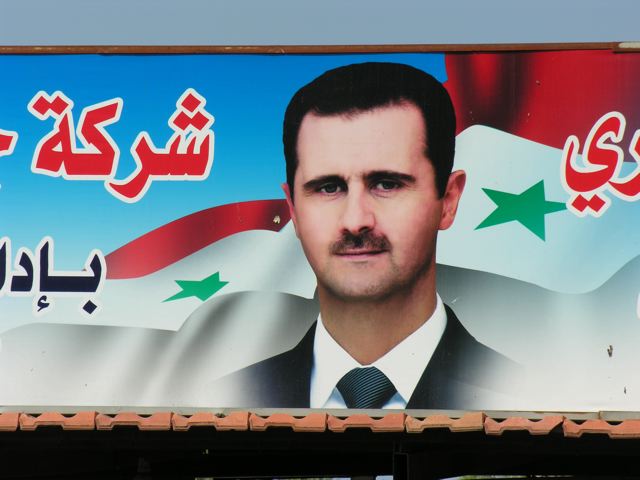David Blair writes: Syria — a small country near Iraq and Israel, a totalitarian rogue state, member of the axis of evil along with North Korea and Iran. That summarises what many of us know about Syria.
I wanted to know more and spent a month travelling this ancient Biblical land. My first impressions were of thriving vibrant cities, vast barren landscapes, valiant efforts at reafforestation, struggling plantations of olives and pomegranates carved out of the desert, and astonishing, fabulous ruins of ancient civilisations. Friendliness, kindness and hospitality are overwhelming. Time after time people smile and say “welcome to Syria”. They really make you feel welcome with innumerable invitations, gifts and smiles. Australians seem to be especially welcome.

But aspects of Syria are disturbing. The first is the desperate state of the environment. Roadsides are mulched with deep drifts of plastic bags. Building rubble and other debris covers the landscape. Rivers are clogged with plastic floating on stagnant ponds. You wonder if anyone cares for this country. Looking up from this ugliness, often what you see is a grand presidential portrait. The face of President Assad is everywhere.
The presidential portraits often appear as threesomes. In the centre, Assad senior, a benign looking fellow who ruled with an iron fist and Soviet support until his death in 2000. On his right Basil al-Assad, the fast living gangster-looking son in dark glasses, who was groomed for his father’s job until he was killed in a car crash in 1994. Opposite him the present president Bashar al-Assad, who was brought back from his ophthalmology career in London once the number one son had died. Bashar looks modest, earnest and somewhat bewildered, staring out from portrait after portrait.
Facing a triple portrait I would often ask a friendly Syrian “which of the three Assad’s was the best?” The answer was often a wry uncomfortable smile followed by “All exactly equal!”. Others said “we do not discuss politics”. It was easy to recognise a culture of fear. The secret police apparatus built by Assad senior has clearly not been fully dismantled. As tourists in eastern Syria we were followed by plain clothes police in unmarked cars for 5 days. It was like a B-grade movie car chase. They were always polite and even helped us when we took a wrong turn. When I asked “why are you following me” they smiled politely “we are just trying to help!”

If you stop reading now you will be left with the western stereotype of Syria — a carbon copy of North Korea. And if I remind you of Assad senior’s brutal suppression of the Muslim brotherhood in the town of Hama in 1982 that killed thousands and practically obliterated the old city, the stereotype will be confirmed.
Yet talking to many Syrians and especially members of Syria’s Christian minority, I came to understand a vastly more complex situation, and the positive role of the present president as he balances and resists enormous forces.
The strongest force is the global force of Muslim fundamentalism. The most extreme form, exported by the Saudi Wahabists, is funded by vast profits from selling oil to the West. Our money is used to build madrassas — Muslim fundamentalist schools — across the Muslim world, but not in Syria which has overwhelmingly public education and quite high literacy. Elsewhere from the Middle East to the Phillipines madrassas provide narrow religious education and indoctrinate young people with literal beliefs about a paradise populated by virgins and rivers of milk and honey. Poor families are tempted by free food and free education. This is the fuel for the fundamentalist storm which is not limited by national boundaries.
In Syria the fundamentalist message is delivered in mosques and by hundreds of religious satellite TV channels from across the Islamic world. Conservative Islam is manifest everywhere especially in the south and east. Women are a rarely seen on the street, and when they are, they are thickly wrapped in black. Most men I met were proud of their huge families — 10 children are not uncommon. As a result Syria has an outrageous population growth of 2.5% per annum which will double the population in 25 years. The fundamentalists are playing the politics of demography. They think on a generational time scale and they aim for a fundamentalist Muslim world.
The second strong force in Syria is Hezbollah, the party of God, powered by Iran. In the West, Hezbollah are made out to be simple terrorists, bent on Israel’s destruction. This may be their basic goal. However in Syria, every Christians and Muslim I spoke to agreed that Hezbollah is a force for good. While socially conservative, they support women’s education and economic development. Next door, in Lebanon they have helped greatly in alleviating rural poverty. The fact that they may also trigger the next war with Israel does not seem to bother most Syrians, although in Lebanon most people are fearful and see the next war coming. The recent visit of Iran’s President Ahmadinijad to Lebanon is seen by many as the final call to action.
The third force in Syria comes from the large Kurdish minority in the north and east. Many Kurds pride themselves on their modernity, secularism and love of European culture. But Syria thinks it can integrate the Kurds into Arab society by prohibiting Kurdish language education and encouraging Arab immigration into Kurdish areas. Possession of Kurdish language books is dangerous. Recently a Kurdish student was gaoled for having a photographs of Kurdish activists on his mobile phone and there are numerous other cases of political repression reported on Kurdish internet sites. Kurdish students I met expressed their frustration — they feel powerless. They look to their compatriots across the borders in Iraq, Turkey and Iran and many wanted to emigrate to Australia. Monolithic state control has sustained the status quo for the time being, but it won’t be a surprise when it explodes.
The fourth force in Syria is the Christian minority. From Damascus to the northwest you find strong Christian enclaves and villages where church spires, neon crosses and rough painted crosses on walls and doors proclaim their faith. It is almost a shock when you suddenly find women on the street and serving in shops, faces visible and interacting freely. Their culture too is vibrant, but there is a sense of insecurity. Their families are small, they are aware of the demographic changes, and many young people aim for higher education and jobs in the West.
Bashar al-Assad has managed to maintain a culture of religious tolerance. Muslims come to pray at some of the Christian shrines, many of which predate Islam. I met Iranian pilgrims visiting the Christian shrine of St Tekla in Maalula and at the “oldest church in the world” at Saidnaya which holds an icon supposedly painted by St Luke. At St Tekla convent the nuns proudly display a picture of Bashar al-Assad and his wife on a visit to the convent. Assad’s government has recently banned the niqab or face veil in schools and universities. Police ostentatiously protect religious processions and other public manifestations of faith. These strong statements of support for religious diversity are clearly appreciated by the Christian minority.
Syria, like China, and like Iraq used to be, is a one party state. All three have been ruthless in suppressing opposition. We all know what the West’s imposition of multi-party democracy has done for Iraq — untold suffering and atrocities that surely eclipse the evils wrought by Saddam. Iraq shows us what can happen when tight internal control is suddenly released. All the Christians I talked to were quite emphatic that their greatest fear was that the stability and moderation maintained by Assad’s regime could fail. Regime change here would guarantee new floods of refugees unleashed on the world.
There is just one political topic that everyone in Syria is happy to discuss — Israel. Everyone is passionate and everyone seems to agree. I met a member of an NGO working with the 1-2 million Iraqi refugees in this country (and we complain about 5000 boat people!). Here is what she had to say: “Your news media only reports half the news. You ignore the injustices. You gloss over the house demolitions, you ignore the people systematically excluded from their homes, you ignore the injustice of the blockade of Gaza. At home you campaign against the death penalty — an eye for an eye is seen as archaic and uncivilised, but when Israel practices hundreds of deaths for a death you say that Israel has a right to protect itself. If one policeman is attacked by a mob would you condone the police killing hundreds of people in revenge? You object to Iran’s nuclear program but ignore Israel’s nuclear arsenal. How would you feel if Israel’s missiles were targeted on your cities?”
Whatever opinions we have on these issues, the Israel-Palestinian conflict is clearly the one force acting to unify rather than divide this country.
While our cultures are very different, Australia and Syria have much in common — a similar population, an arid land and a multicultural society. It would be in our interests to engage with Syria to help it move gradually towards pluralism and moderation. We need to understand Islam better, and for the benefit of the whole world we should encourage and assist Syria to reverse its catastrophic deforestation and pollution. The Lonely Planet guide says that Syrians are the nicest people in the world. On this point I have to agree.







Crikey is committed to hosting lively discussions. Help us keep the conversation useful, interesting and welcoming. We aim to publish comments quickly in the interest of promoting robust conversation, but we’re a small team and we deploy filters to protect against legal risk. Occasionally your comment may be held up while we review, but we’re working as fast as we can to keep the conversation rolling.
The Crikey comment section is members-only content. Please subscribe to leave a comment.
The Crikey comment section is members-only content. Please login to leave a comment.